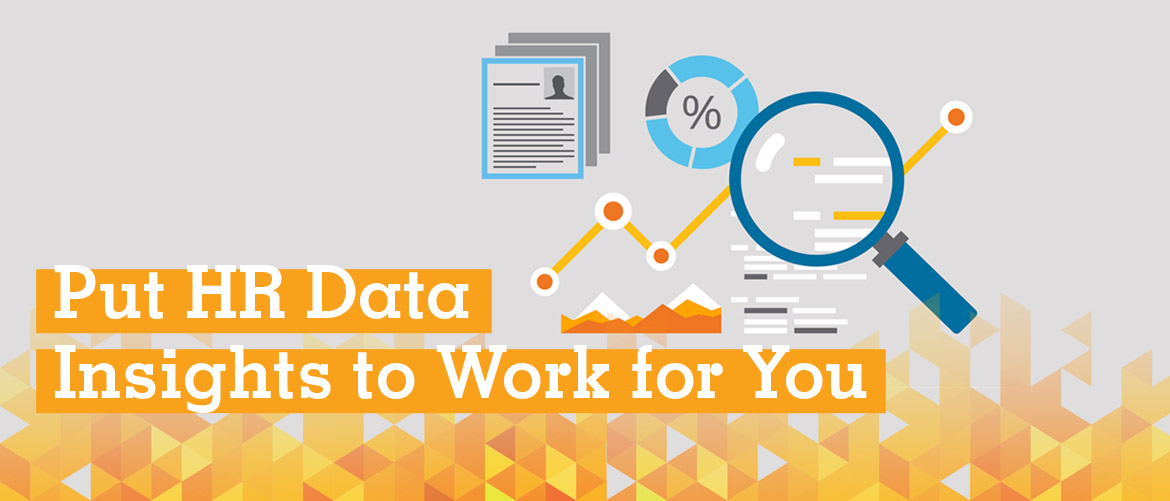
HR drives business performance by delivering competitive advantage through people. Since performance relies on measures, HR can contribute to business success by embracing the power of data insights. Finance and sales departments have been using data to strengthen company success for decades. And today, HR is increasingly getting in on the action.
HR already collects critical employee metrics, including payroll data, turnover, benefits cost per employee, and demographics. The key is to collect and analyze data, and use those findings to make business decisions and improve your bottom line. If you're new to data analytics, Bersin by Deloitte (a research and advisory service) recommends starting small. Partner with an experienced colleague on an analytics project to tackle an HR problem, such as reducing turnover, improving engagement, or reducing accidents. Experience and insights will give you knowledge about how to make data work for you.
Everyday ways data can benefit you
Recruitment
Your people are the powerhouse of your company and recruitment is key to getting the right talent on board. But the reality is that recruitment is an HR process plagued with biases that can lead to costly hiring mistakes.
The Harvard Business Review article “In Hiring, Algorithms Beat Instinct” suggests that 85%–97% of professionals rely on intuition when it comes to assessing a candidate. A poor hiring decision made on intuition alone can cost you thousands of dollars. In a 2013 CareerBuilder survey, 27% of employers said a bad hire cost them more than $50,000.
You’re more likely to find the right fit when hiring decisions are supported by hard data (e.g., analysis of skills, knowledge, and experience), coupled with manager input. Studies show that companies that make fact-based workforce decisions perform better than those that don’t. A 2013 CEB Corporate Leadership Council survey found that companies leading the way in the use of analytics had 12% better talent outcomes than the average company.
Compensation
According to Laine Thomas Conway, a partner in the Talent & Rewards Best Practice team at Aon Hewitt, data should be used to drive compensation decisions, especially as variable pay becomes more common. At a baseline level, data can be used to determine internal benchmarks (pay ranges), external benchmarks (market pay), and performance ratings. Thomas Conway cites two obstacles to the use of data for compensation decisions: 1) data is not readily available, and 2) managers are not trained how to use data effectively. Without the use of hard data, compensation decisions are often made on personal judgments that can lead to inequitable pay practices.
Paying employees is the most expensive budget item for most companies. That’s why it’s so important to make sure you’re compensating your employees in the most efficient way possible. Sticking with the status quo is the easiest thing to do, but not knowing your employees’ real value may have a direct impact on your company’s recruitment and retention initiatives. When it comes to compensation, data analytics can give your company the upper hand in securing the top talent you need to succeed.
Retention
Another advantage of using big data in the workplace is the opportunity to learn why employees leave – and what makes them stay. With the use of data analytics, Xerox cut its call center attrition rate by 20%. Data helped Xerox determine that individuals they identified as “creative” types were more likely to stay with the company than those who were “inquisitive.” They gathered data by putting applicants through a series of tests and then tracked their job performance.
In addition, Xerox identified several characteristics of their ideal call center worker. He or she is a person who lives near the job, has reliable transportation, and uses one or more social networks, but not more than four. And he or she tends not to be overly inquisitive or empathetic, but is creative. Since Xerox invests $5,000 to train each call center employee, reducing attrition was a big win for its bottom line. These types of employee insights are universal and apply to all businesses of any size. The key is to find the right partner to help you turn raw data into winning solutions.
Source: "Meet the New Boss: Big Data," The Wall Street Journal, http://www.wsj.com/news/articles/SB10000872396390443890304578006252019616768


RELATED RESOURCES
Welcome to ADP TotalSource, a modern way to manage, engage and unlock your workforce.
Partnering with ADP TotalSource is like gaining your very own highest-grade HR department to adapt to and support your business's growth. From helping you stand out to attract and keep top talent to offering competitive benefits that rival Fortune 500® company packages, ADP TotalSource can provide what you need, when you need it.
Backed by the big-data power and reliability of ADP, yet designed to be nimble, scalable and adaptable to fit your precise objectives, ADP TotalSource is a personal extension of your business to help you manage and engage your team, mitigate compliance risk, and stay ahead of the competition.

LIMITED TIME OFFER:
No Setup Fee (up to $2,500 value!)
(844) 520-9672
(All fields are required.)
The ADP Logo and ADP are registered trademarks of ADP, LLC. All other trademarks and service marks are the property of their respective owners. ADP, LLC.




